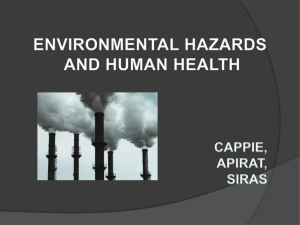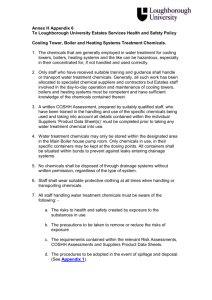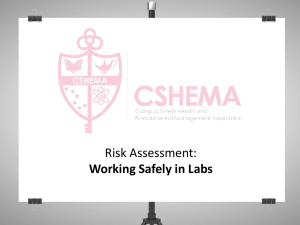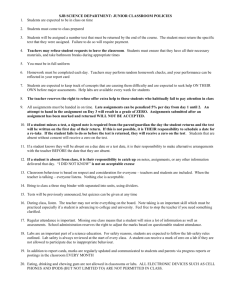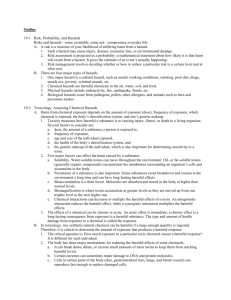Envir Studies Ch 10 – Risk, Toxicology, Human Health
advertisement
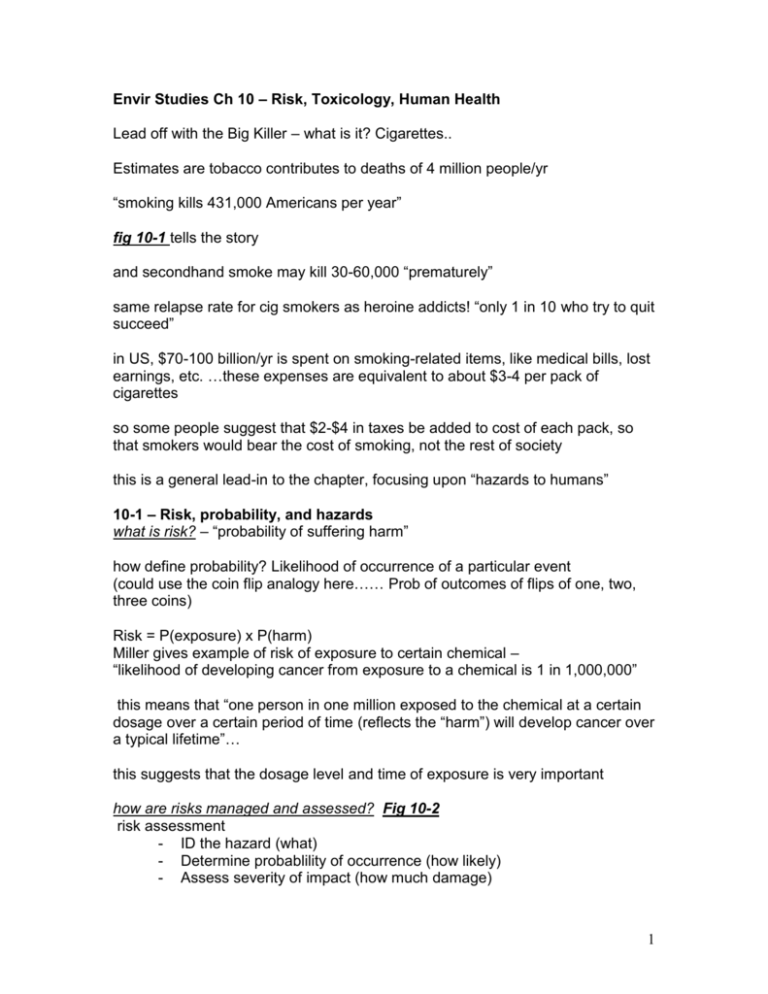
Envir Studies Ch 10 – Risk, Toxicology, Human Health Lead off with the Big Killer – what is it? Cigarettes.. Estimates are tobacco contributes to deaths of 4 million people/yr “smoking kills 431,000 Americans per year” fig 10-1 tells the story and secondhand smoke may kill 30-60,000 “prematurely” same relapse rate for cig smokers as heroine addicts! “only 1 in 10 who try to quit succeed” in US, $70-100 billion/yr is spent on smoking-related items, like medical bills, lost earnings, etc. …these expenses are equivalent to about $3-4 per pack of cigarettes so some people suggest that $2-$4 in taxes be added to cost of each pack, so that smokers would bear the cost of smoking, not the rest of society this is a general lead-in to the chapter, focusing upon “hazards to humans” 10-1 – Risk, probability, and hazards what is risk? – “probability of suffering harm” how define probability? Likelihood of occurrence of a particular event (could use the coin flip analogy here…… Prob of outcomes of flips of one, two, three coins) Risk = P(exposure) x P(harm) Miller gives example of risk of exposure to certain chemical – “likelihood of developing cancer from exposure to a chemical is 1 in 1,000,000” this means that “one person in one million exposed to the chemical at a certain dosage over a certain period of time (reflects the “harm”) will develop cancer over a typical lifetime”… this suggests that the dosage level and time of exposure is very important how are risks managed and assessed? Fig 10-2 risk assessment - ID the hazard (what) - Determine probablility of occurrence (how likely) - Assess severity of impact (how much damage) 1 Miller points out that risk assessment is “complex, difficult, controversial” After assessment, management occurs. This is also complex, involves deciding: - how serious is one risk relative to another - how much should risk be reduced - how you reduce the risk - how much to spend to reduce the risk Miller points out that the management process is even tougher than assessment This overall process is often called “cost-benefit analysis” Major types of hazards cultural (poor diet, unsafe workplaces, etc) chemical (in air, water, soil, food) physical (radiation, equakes, hurricanes, etc) biological (disease, animals) 10-2 Toxicology Determination of harm Toxicity is dependent upon: - dosage - response of the person to the dose Specifically, several factors control the level of harm: size of dose how often dose occurs child vs adult person’s immune system genetic makeup (only now starting to realize how important genes may be…) some of the technical factors that dictate the level of harm are: solubility (water-soluble toxins get into water supplies; oil-soluble toxins can accumulate in tissues) persistence (resistance to breakdown to less harmful substances) bioaccumulation (storage of compounds in tissues) biomagnification (toxin concentrations increase as they move through food chain) fig 10-4 – important diagram, inverse of the food pyramid chemical interactions – another very important, very poorly understood factor – examples of “antagonistic” and “synergistic” interactions 2 synergistic reactions magnify problems for example, risk of asbestos worker contracting lung cancer is 20 times more than a “normal” person but risk of asbestos worker WHO SMOKES contracting lung cancer is 400 times more than a “normal” person obviously, there is some synergistic relation with asbestos and smoking that greatly increases risk of lung cancer trace levels of toxins – are these a problem? Well, it depends … Concentration is very important – “detection of trace elements does not necessarily mean they will cause harm to most people” o For example, 100 cups of coffee may deliver a lethal dose of caffeine o 100 tablets of aspirin may be lethal o 1 liter of alcohol may be lethal another important point – “ability of chemists to detect increasingly small amts of chemical can give the FALSE Impression that dangers from toxic chemicals are increasing” 1980 – we could detect 1 ppm (1 part per million) concentrations 1990 - we could detect 1 ppb (1 part per billion) concentrations 2000 – we can detect 1 ppt 1 part per trillion) concentrations just because we can detect 1 ppt does NOT mean that 1 ppt has been shown to be harmful.. could it be harmful? Perhaps is it known to be harmful? Not necessarily there is a huge range of toxicity levels – see Table 10-1 how is toxicity determined? 3 methods… 1. case studies by doctors 2. lab investigations on animals 3. epidemiological studies – statistical studies these lead to dose-response models Fig 10-6 3 dose-response models can show threshold or no threshold….that is, sometimes it takes a certain minimum level of chemical to create an effect…this is the “threshold” value How is epidemiology used to determine toxicity? Many studies are done using Experimental group Control group These are “controlled” studies in medicine where all things are held constant except for one thing, often a new drug delivered to the experimental group Then results of two groups are compared, and if there is a significant difference, it is likely due to the new drug This same approach is used when possible to study harmful substances, but under less controlled conditions, and reliability of results or conclusions is much less. 10-3 – Chemical Hazards Types toxic & hazardous chemicals mutagens – cause changes in DNA teratogens – cause birth defects carcinogens – cause cancer how do chemicals harm the immune, nervous, and endocrine systems? Immune system – cells and tissues protect the body by forming antibodies, then the antibodies attack the invader Nervous system – gets attacked by poisons and chemicals Endocrine system – system of glands & hormones that regulates many body functions. Each hormone has a specific shape that allows it to attach to certain cell receptors (Fig 10-7). The problem is that chemicals can disrupt hormone attachment, sometimes by “mimicking” a hormone and attaching themselves to the receptor. Why do we still know so little about the harmful effects of chemicals? We know a lot about a few chemicals, a little about many chemicals, and very little about most chemicals..why? 4 Testing and evaluation is very expensive. Then couple that with synergistic effects of chemicals… Example – study of 3-chemical interactions of the 500 most widely used industrial chemicals would require 20,700,000 experiments!! Miller discusses the “precautionary approach” – this is a cornerstone of some environmental groups and movements…precautionary principle states that if there is uncertainty about potentially harmful chemicals, decisions should be based primarily to protect human health and the environment. The idea is that “those proposing a new chemical or technology would bear the burden of establishing its safety”. This sounds good, “better be safe than sorry”, but this could slow down new chemical and technological development significantly…. 10-4 Biological hazards 2 types of disease nontransmissible – not caused by living organisms – causes often multiple and poorly understood – examples: asthma, cancer, diabetes transmissible – caused by living organisms – bacteria, virus, protozoa, etc these organisms are called “pathogens” - bacteria are one-celled organisms that replicate by cell division - a virus is noncellular, and its DNA “contains instructions for making more viruses but has no apparatus to do so”. So the virus invades a host cell, takes over the host cell’s DNA to create a “factory” to create more virus. Antibiotics have cut down on infectious disease caused by bacteria, but the bacteria can develop resistance and become immune. The biggest infectious disease killers are: pneumonia and flu (bacteria and viruses) AIDS (virus) Diarrhea (bacteria and virus) TB (bacterial) Malaria (parasitic protozoa) Measles (virus) Hepatitis B (virus) 3.7 million/yr 3 million/yr 2.5 million/yr 2 million/yr 1.5 million/yr 1 million/yr 1 million/yr 5 Miller notes that a major transition occurs in the types of diseases striking a country as it becomes more industrialized. “infectious diseases of childhood become less important, while the chronic diseases of adulthood become more important.” Striking 1999 statistic: Infectious and parasitic diseases were responsible for 43% of deaths in developing countries, 1 % of deaths in developed countries spread of viral diseases most common viral diseases are Influenza (flu), transmitted by body fluids or airborne Ebola, transmitted by blood or body fluids Rabies, transmitted by animals AIDS, transmitted by blood or body fluids Miller notes that viruses can genetically adapt, just like bacteria, so they can become immune to treatments Still most dangerous is the flu, in part because they can move through air and are highly contagious. Example – 1918-19, flu epidemic killed 20-30 million worldwide, including 500,000 in the U.S. Sex can be very dangerous, in terms of STDs. 15 million are affected in US every year. AIDS could be a huge killer long term. 56 million people infected with HIV now, with add’l 5 million/yr getting infected. Within 7-10 years, at least half of those infected with HIV develop AIDS. Still no known cure, although people are living longer and there is much research being done. 10-5 Risk Analysis how do we estimate risk?? Perform risk assessment by ID’ing hazards & evaluating risk Rank risk Determine options for reducing or eliminating risk Communicate findings to decision-makers Figure 10-12 very interesting contrast between ranking of problems perceived by scientists vs those perceived by citizens – some big diffs in the order of importance…. 6 Scientists rank air pollution, exposure to chemicals, drinking water contam, and pesticides in foods at the TOP of their list, while the public ranks these at the BOTTOM (!) Once risks have been determined, there are several methods to determine the “acceptability” of the risk (Fig 10-13) Cost- benefit (acceptable if benefits outweigh costs) Natural standards (acceptable if on par with a natural hazard) Expressed preference (people agree to take risk) Revealed preferences (acceptable if no worse than current) What are the greatest risks people face, in terms of shortening their life span? See FIG 10-14 (p.240) Poverty shortens life span 7-10 years Being a male shortens it 7.5 years Smoking shortens it 6 years Overweight shortens it 2-6 years Being unmarried shortens it 5 years Finally, how well do we perceive risk? Not very well, it turns out. For example, some activities we enjoy carry high risk of death: - motorcycling (1 in 50) - smoking (1 in 300) - hang-gliding (1 in 1250) - driving (1 in 5000) but others that we think of as terrifying are very low risk: - commercial airline crash (1 in 4.6 million) - train crash (1 in 20 million) - snakebite (1 in 36 million) - shark attack (1 in 300 million) 7


